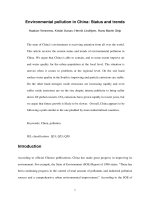Rock and Mineral pot
Bạn đang xem bản rút gọn của tài liệu. Xem và tải ngay bản đầy đủ của tài liệu tại đây (11.94 MB, 49 trang )
Eye Wonder
4-5
Rocky Earth
6-7
A volcanic beginning
8-9
Making of a rock
10-11
Igneous rock
12-13
Sedimentary rock
14-15
Metamorphic rock
16-17
Rocks from space
18-19
Hidden beauty
20-21
Breakdown
22-23
Carving a path
24-25
Crystals
26-27
What a gem!
LONDON, NEW YORK, MUNICH,
MELBOURNE, and DELHI
Contents
First published in Great Britain in 2004 by
Dorling Kindersley Limited
80 Strand, London WC2R 0RL
2 4 6 8 10 9 7 5 3 1
A Penguin Company
Copyright © 2004
Dorling Kindersley Limited, London
A CIP catalogue record for this book
is available from the British Library.
All rights reserved. No part of this publication
may be reproduced, stored in a retrieval system,
or transmitted in any form or by any means,
electronic, mechanical, photocopying, recording,
or otherwise, without the prior written permission
of the copyright owner.
ISBN 1-4053-0090-6
Colour reproduction by Colourscan, Singapore
Printed and bound in Italy by L.E.G.O.
see our complete
catalogue at
www.dk.com
Written and edited by Caroline Bingham
Designed by Helen Chapman
Publishing manager Susan Leonard
Managing art editor Clare Shedden
Jacket design Chris Drew
Picture researcher Sarah Stewart-Richardson
Production Shivani Pandey
DTP Designer Almudena Díaz
Consultant Kim Dennis-Bryan PhD, FZS
With thanks to Victoria Long
for design assistance.
28-29
Precious metals
30-31
Get that metal!
32-33
Using rocks in art
34-35
Rocks in history
36-37
Building rocks
38-39
A touch of mystery
40-41
History in a rock
42-43
Hunting for rocks
44-45
What does it make?
46-47
Glossary
48
Index and
acknowledgements
4
c
a
r
c
o
m
p
u
t
e
r
c
l
o
t
h
e
s
t
e
l
e
p
h
o
n
e
j
e
w
e
l
l
e
r
y
y
o
u
a
n
d
m
e
!
house
Rocky Earth
Rocks and minerals are
important. They make up
much of our planet and are
mined to provide many of the
things around us, from cars to
computers. Even your body
contains minerals that
keep you alive.
t
o
o
t
h
p
a
s
t
e
Store cupboard
The things we use
in our everyday
lives come from our
planet, Earth. The
raw ingredients are
all taken from the
crust. We cannot
drill any deeper.
Most of the crust
and mantle is
made from lots
of different
rocks, all
squashed
together.
5
Let’s make a rock
Rocks are made up of crystals of
minerals. Different amounts of minerals
make up different rocks (though some
rocks are made from just one mineral).
Let’s make shampoo
What forms the shampoo you use on your
hair? Minerals, including those below!
Earth’s crust is
between 5 and
68 km (3
1
⁄2 and
42 miles) thick.
Quartz
(grey)
Scientists believe
the Earth was
born about 4,600
million years ago.
++ =
+
+
=
quartz crystals
feldspar crystals
mica crystals
granite (a type of rock)
coal tar
lithium clay
selenium
shampoo
M
a
n
t
l
e
E
a
r
t
h
’
s
c
r
u
s
t
O
u
t
e
r
c
o
r
e
C
o
r
e
Mica
(black)
Feldspar (pink
and white)
•
Your body contains more than
60 minerals. Nine of these are
essential for life.
•
Some minerals take thousands of
years to form. Some form in minutes.
Mineral facts
Squeeze clay in your hands and it oozes
between your fingers. This is a little like what
happens inside a volcano. The pressure grows
until the volcano erupts. Whoosh! It is the
first step in the formation of new rocks.
A volcanic beginning
T
h
e
m
a
g
m
a
i
s
f
o
r
c
e
d
u
p
i
n
s
i
d
e
t
h
e
v
o
l
c
a
n
o
.
Magma (molten
rock) chamber.
Previous eruptions
have formed a cone-
shaped exterior.
No place for a rock?
Deep, deep under the Earth’s crust it is
hot enough to melt rock. This molten rock
sometimes builds up in chambers and bursts
through weak spots in the Earth’s crust.
When magma
leaves a volcano,
it is called lava.
Shiprock
Shiprock Pinnacle is all that
remains of an ancient
volcano. It is the
hardened core.
Just a cliff?
The eruption
of a volcano
can create deep
layers of ash,
dust, and rock
at its base.
It changes
the landscape.
Volcanic debris
ranges from dust
and ash to rocks
the size of houses.
Shiprock Pinnacle in
New Mexico was once
a plug of magma
filling the chimney
vent of a volcano.
Avalanche of rock
A volcano erupts
with such power that
sometimes the eruption
destroys a part of the
volcano. Huge rocks
shoot into the air.
S
h
i
p
r
o
c
k
P
i
n
n
a
c
l
e
i
s
n
a
m
e
d
a
f
t
e
r
a
s
h
i
p
a
s
i
t
l
o
o
k
s
a
l
i
t
t
l
e
l
i
k
e
o
n
e
.
Do you think that all rocks look the same?
In fact, there are many different kinds of
rocks, but they can be divided into three
basic types, which are being formed (and
destroyed) as you read this book.
Making of a rock
In the beginning
Earth’s first rocks
were igneous rocks.
These form from
molten rock that has
cooled and hardened.
Chipping away
One way sedimentary rock
forms is when pieces of
rock are carried to the sea
where they create huge
piles of sediment. After
thousands of years these
cement together.
Molten volcanic
rock cools to form
igneous rock.
S
e
d
i
m
e
n
t
a
r
y
r
o
c
k
S
e
d
i
m
e
n
t
s
a
r
e
9
Sediment settles on
the bottom of seas,
rivers, and lakes.
b
u
i
l
d
s
u
p
i
n
l
a
y
e
r
s
.
Getting hotter
Rub your hands together and
they get hot. Metamorphic
rock forms when rocks are
squeezed and heated deep
under the Earth’s crust.
The pressure and heat as
granite is forced up causes
the development of the
metamorphic rock marble.
Granite
D
e
e
p
u
n
d
e
r
t
h
e
e
a
r
t
h
,
r
o
c
k
s
a
r
e
b
e
i
n
g
s
q
u
a
s
h
e
d
a
n
d
h
e
a
t
e
d
.
ROCKING AROUND
Over thousands of years,
each type of rock can
change into one of the
others depending on
what happens to it, from
igneous to sedimentary
to metamorphic.
Marble
s
q
u
a
s
h
e
d
t
o
g
e
t
h
e
r
.
10
Igneous rocks form the greatest part
of Earth’s rocky crust, but can also be
seen in the land around us. A famous
igneous rock landscape is the Giant’s
Causeway in Northern Ireland.
Igneous rock
Pumice is an igneous
rock from the heart
of a volcano.
Pele’s hair looks
like hair! It forms
from sprays of lava.
Obsidian has a shiny surface.
It contains a lot of glass.
Built to last
The most common igneous rock is granite.
It is incredibly strong, and has been used
for building for thousands of years.
From hair to glass
A volcano produces a great
variety of igneous rocks.
Just take a look at the three
examples shown above.
L
o
n
d
o
n
’
s
T
o
w
e
r
B
r
i
d
g
e
u
s
e
s
g
r
a
n
i
t
e
.
P
u
m
i
c
e
s
t
o
n
e
i
s
t
h
e
o
n
l
y
f
l
o
a
t
i
n
g
r
o
c
k
.
11
Giant’s Causeway
The Giant’s Causeway in Antrim,
Northern Ireland, formed when basalt
lava cooled and shrank. This type of
lava can create hexagonally
shaped columns.
L
e
g
e
n
d
s
s
a
y
g
i
a
n
t
s
u
s
e
d
t
h
e
c
a
u
s
e
w
a
y
a
s
s
t
e
p
p
i
n
g
s
t
o
n
e
s
.
•
“Igneous” comes from the
Latin word for “fire”.
•
The more slowly that a rock
cools from its molten form, the
larger the crystals.
•
Granite cools slowly and has
large crystals. Obsidian, which
cools quickly, has small crystals.
Igneous facts
Towering chalk cliffs are an
amazing example of sedimentary
rock. They are formed from the
shells and skeletons of microscopic
sea creatures. Just imagine how
many are needed to build a cliff.
Sedimentary rock
One by one
The sea creatures that
break down to create chalk
are tiny. It’s thought that
these cliffs grew by 0.5 mm
(0.02 in) a year – that’s
about 180 of these creatures
piled on top of one another.
In places, these
cliffs are 90 m
(300 ft) high.
Year 1
From plant to rock
Another way in which
sedimentary rocks form is
by the breakdown of plants.
As they are buried, they
are squeezed together,
eventually forming coal.
12
M
o
v
e
m
e
n
t
s
i
n
t
h
e
E
a
r
t
h
’
s
c
r
u
s
t
h
a
v
e
l
i
f
t
e
d
t
h
e
c
l
i
f
f
s
o
u
t
o
f
t
h
e
s
e
a
.
From plant matter
to peat
Let’s play
Do you like to play
in golden sand? This
is a sediment. Left for
thousands of years,
it may eventually
form sandstone, a
sedimentary rock.
Rocks are continually
eroded, over millions of
years, to produce sand.
at 90 million years and after 360 million years.
A
s
w
e
l
l
a
s
t
i
n
y
s
h
e
l
l
s
,
i
t
c
a
n
c
o
n
t
a
i
n
l
a
r
g
e
f
o
s
s
i
l
s
.
C
h
a
l
k
t
a
k
e
s
m
i
l
l
i
o
n
s
o
f
y
e
a
r
s
t
o
f
o
r
m
.
All mixed together
This sedimentary rock has formed
when pebbles have cemented
together, a bit like a cake mix.
to coal
to lignite
to bituminous
coal
13
14
“Metamorphic” comes from the ancient Greek
words, meta (meaning change) and morphe
(meaning form). When rocks are heated or
compressed, this type of rock forms.
Metamorphic rock
Marble magic
Marble is a beautiful
metamorphic rock. It
is mined by being cut
into huge blocks with
strong cutting wires.
A peek at slate
The metamorphic rock slate
forms from mud and a rock
called shale. The shale
has been squeezed and
compressed as mountains
are pushed up. Slate splits
easily into sheets.
Underground changes
One way metamorphic rocks
form is when mountains are
pushed up out of the Earth’s
crust. Mountains and hills
surround this old slate quarry.
Each block weighs thousands of tonnes.
M
a
r
b
l
e
c
a
n
b
e
c
a
r
v
e
d
i
n
t
o
s
t
a
t
u
e
s
.
15
The dark host
rock contains
swirls of a lighter
coloured rock.
A shimmering palace
Polished marble looks stunning when used
for building, and perhaps the world’s most
famous marble building is the Taj Mahal
in India. The marble shimmers in the sun.
Icecream swirls
When rocks are heated,
parts may begin to melt
and run through a “host”
rock. This makes swirly
patterned metamorphic
rock. The rock is
called migmatite.
W
a
t
e
r
c
o
o
l
s
t
h
e
c
u
t
t
i
n
g
e
q
u
i
p
m
e
n
t
i
n
a
q
u
a
r
r
y
.
Marble is formed from limestone.
16
We cannot see it, but about 23 tonnes
(25 tons) of dust rain down on Earth
every day. This fine dust arrives from
space. Occasionally a rock from
space hits Earth; this is
called a meteorite.
A meteorite hit
Meteorites are pieces of rock
or metal that hit Earth. Some
have broken off asteroids, large
chunks of rock that orbit the
Sun between Mars and Jupiter.
Most are fragments of comets.
Rocks from space
What’s inside?
Meteorites from asteroids
contain metals such as iron
as well as rocks. Those from
comets contain more rock
than metal.
M
e
t
e
o
r
i
t
e
s
h
i
t
E
a
r
t
h
.
M
e
t
e
o
r
s
b
u
r
n
u
p
a
b
o
v
e
i
t
.
There is evidence that a
massive meteorite hit Earth
65 million years ago, causing
the dinosaurs to die out.
C
o
m
e
t
s
p
a
s
s
o
n
b
y
.
17
The pitted surface is
created by the immense
heat as the meteor “rubs”
against the atmosphere.
What’s that hole?
If a large meteorite hits Earth it can form
a crater, changing the surroundings where it
lands. It would take you about 30 minutes to
walk across this meteorite crater in Australia.
I spy a shooting star
Meteors or shooting stars can be
seen as they burn up in Earth’s
atmosphere, usually more than
80 km (50 miles) above our heads.
M
o
s
t
m
e
t
e
o
r
s
a
r
e
t
h
e
s
i
z
e
o
f
a
s
m
a
l
l
p
e
b
b
l
e
.
A
l
a
r
g
e
m
e
t
e
o
r
i
t
e
m
a
y
b
e
t
r
a
v
e
l
l
i
n
g
a
t
4
0
,
0
0
0
k
m
/
h
(
2
5
,
0
0
0
m
p
h
)
w
h
e
n
i
t
h
i
t
s
.
This crater is so
old that trees have
grown in its base.
Just passing
Comets are a bit like
huge snowballs, but made
of ice, gases, and dust. They
orbit the Sun, developing long
tails as they near Earth.
A comet’s tail
is narrow but
it can stretch
for hundreds
of kilometres.
ONCE IN A LIFETIME
One of the most famous comets, Halley’s,
was included in the Bayeux Tapestry,
which was stitched more
than 900 years ago. This
comet passes Earth just
once every 76 years. It
last passed us in 1986.
18
Brrrr! A cave is a damp, dark,
chilly place. However, if you are
lucky enough to visit a large
cave that has been lit and
opened to visitors, you’ll
discover incredibly
beautiful shapes
in the rocks.
Hidden beauty
Water damage
Over the course of thousands of
years, a constant flow of water
will eat away at a solid area of
rock. After 100,000 years, this
may have formed a small cave,
which will continue to grow.
T
h
i
s
c
a
v
e
h
a
s
o
p
e
n
e
d
i
n
t
o
a
v
a
s
t
c
a
v
e
r
n
.
This stream falls
further than
the length of
a football pitch.
Soft centre
Have you ever eaten a hard sweet
with a soft centre? Volcanic caves
can form when soft lava pushes on
through a hardened outer layer.
Build it up
Cave formations can be amazingly
complicated. These slender shapes
have built up gradually, as drops of
water have deposited traces of a
mineral called calcite.
A funny shape
Stalactites hang down
while stalagmites grow up.
It can take 1,000 years for
these formations to grow
less than a centimetre.
T
h
e
s
e
v
o
l
c
a
n
i
c
c
a
v
e
s
w
e
r
e
o
n
c
e
m
i
n
e
d
f
o
r
m
i
l
l
s
t
o
n
e
s
.
The tallest
stalagmite in the
world is the height of
a six-storey house.
Rock
formations in
caves build up
drip by drip.
19
20
Rocks are not as permanent as you
may think. From driving rain to
frothy seas, when rocks are exposed
to wind, water, glaciers, or shifts in
temperature, changes begin to happen.
Breakdown
Attack by wind and water
Hoodoos are columns of soft sandstone
topped by harder rock caps. The cap has
protected the rock beneath it from being
washed away by heavy downpours of rain.
Attack by sea
A long time ago, these stacks
were a part of Australia’s
coastline, but they have been
cut off from the coast after an
ongoing battering from the sea.
The layers that make
up the sedimentary
rock in these hoodoos
can be clearly seen.
T
h
e
s
u
r
r
o
u
n
d
i
n
g
r
o
c
k
h
a
s
b
e
e
n
w
a
s
h
e
d
a
w
a
y
.
21
Attack by acid rain
Pollution from cars and lorries
attacks rock. The gases are carried
in rainwater to make acids that
eat into rock – as shown by
the damage to this
sculpture.
Attack by river
Over millions of years, the Colorado
River has carved its way down into
America’s Grand Canyon, exposing
rock faces 1,829 m (6,000 ft) deep.
E
r
o
s
i
o
n
c
a
u
s
e
s
s
e
d
i
m
e
n
t
.
If a hoodoo loses
its protective cap,
the structure will
soon begin to
wear away.
H
o
o
d
o
o
s
f
o
r
m
s
p
e
c
t
a
c
u
l
a
r
s
h
a
p
e
s
,
a
l
l
c
l
u
s
t
e
r
e
d
t
o
g
e
t
h
e
r
.
Erosion facts
•
The wearing away of a
landscape is known as erosion.
•
Plants add to rock erosion
as their roots burrow their
way into cracks in rocks.
•
When rocks are broken
down where they stand, it
is known as weathering.
A glacier is a huge mass of slow-
moving ice. Born as snow builds up
at the top of a mountain, it begins
to force its way forward, picking
up rocks and boulders as it moves.
Carving a path
Slow progress
Glaciers usually creep just
a few centimetres a day.
They end lower down the
mountain where the water
melts away, or at the coast
where large blocks break off.
22
T
h
e
f
o
r
c
e
o
f
a
g
l
a
c
i
e
r
i
s
e
n
o
u
g
h
t
o
c
r
u
m
b
l
e
r
o
c
k
.
From rock to flour!
The sides and base of a
glacial valley are covered
with plenty of scrapes and
scratches. This scraping
produces fine grains of
rock, known as rock flour.
Sprinkle on the colour!
Mountain lakes are often incredible
shades of turquoise blue. This is
because of the rock flour fed
into them by a melting glacier.
A glacier carves a
deep valley as it
moves forwards.
Tiny particles of rock
in the water catch the
light in a certain way.
S
o
m
e
i
s
d
e
p
o
s
i
t
e
d
i
n
m
o
u
n
t
a
i
n
l
a
k
e
s
.
R
o
c
k
f
l
o
u
r
i
s
c
a
r
r
i
e
d
o
n
d
o
w
n
t
h
e
g
l
a
c
i
e
r
.
Adding the stripes
As a glacier works its way forward,
it picks up all sorts of rocks and
sediment. This forms darker streaks
on the surface of the glacier.
FANCY AN ICE LOLLY?
The word crystal comes from the Greek
word kyros, which means “icy
cold”. The ancient Greeks
thought quartz crystals were
made of ice that had frozen
so hard it could not melt.
24
Have you ever cut a paper snowflake?
Snowflakes are made from small ice crystals
that collide and stick together. Crystals also
form in rock, and can be cut and polished.
From little to big
The tiny crystals that make
up the endless golden sands
of a desert are made of
quartz. Quartz can also
form gigantic crystals.
The largest rock crystal
was about 6 m (20 ft) long!
Beautiful colours
Many crystals come in a rich
range of colours. This purple
amethyst is a form of quartz.
It can also be lilac or mauve.
Crystals
surrounding conditions
remain the same.
Crystals continue to grow
as long as the
Is it a thread?
Not all rock crystals are hard.
This is a crystal called tremolite.
It forms flexible strands similar
to the fibres in material. But you
wouldn’t be able to sew with
tremolite. It could make you ill.
The power to heal?
Some people believe that certain
crystals have special powers. Jade
is thought to help relaxation,
lapis lazuli to help friendships.
Seems a bit salty
Salt may not seem like a
rock, but it is a crystalline
rock. In Bolivia there is
even a hotel built from
salt bricks, including
the chairs and tables!
Strands of tremolite have a
silky, translucent look because
light passes through the fibres.
25
S
a
l
t
c
r
y
s
t
a
l
s
f
o
r
m
w
h
e
n
s
e
a
w
a
t
e
r
e
v
a
p
o
r
a
t
e
s
.
A
m
e
t
h
y
s
t
i
s
p
r
i
z
e
d
f
o
r
i
t
s
c
o
l
o
u
r
.
Polished jade
Lapis lazuli









